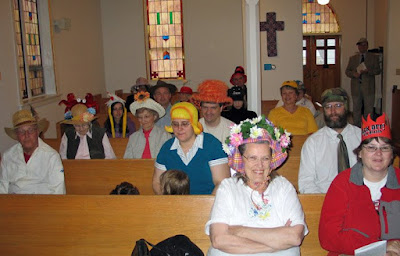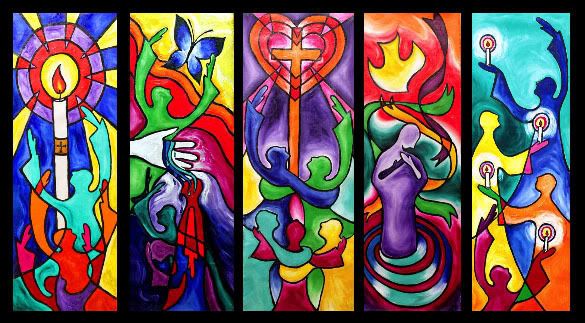by Pastor Laura Gentry
On Easter Sunday—two weeks ago—my husband and I headed to Dubuque after we’d finished our Easter worship duties. We were celebrating the resurrection with my parents. Since it was just the four of us this year, we opted not to make our own feast. Instead, we went out for a fancy buffet. I haven’t been to a buffet in a long time. I’d forgotten how difficult it is to make choices about what to eat at an all-you-can eat banquet. After a while, you get too full to walk and you have to sort of roll yourself out to the parking lot. I remember once I ate so much at a buffet that I announced I was unable to even lick my spoon! Though this year’s Easter banquet was delicious, I ended up thinking how ridiculous it was that we’d eaten quite that much.
Yet now as I continue to study the resurrection scripture lessons through the season of Easter, I am beginning to think our massive Easter banquet was actually appropriate. Why? Because as the gospel of Luke describes it, Easter is not just about the empty tomb, it is about eating. Jesus himself, it seems, spent the first Easter eating.
In the portion before today’s Gospel reading, Jesus makes himself known to two disciples in Emmaus through the breaking of the bread. Now in today’s reading, he demonstrates that he is not a ghost by devouring a piece of fish. His disciples gather around the table too. Like us, they celebrated the resurrection of Jesus by sharing a meal—perhaps they didn’t get a fancy “omelet station” like I did at the Easter buffet I attended, but they had a meal nevertheless.
And it wasn’t their first meal together. We remember, of course, the last supper Jesus and his disciples shared in the upper room the night he was betrayed. At that meal, he assured them that he would be with them in the bread and wine even after he was gone from them in body. No wonder the disciples later recognized Jesus in the breaking of bread at Emmaus—it reminded them of this landmark last supper.
But Jesus had already spent his entire ministry with the disciples, he had already shared countless meals with them and he had already given them the amazing experience of the last supper—a gift that would keep on giving. So why would he need to keep showing up after the resurrection to convince them that he had really risen?
We don’t know Jesus’ motivation for sure but we do know what his post-resurrection appearances accomplished in the disciples. It gave them a deep sense of forgiveness. Remember that according to the gospels, the disciples weren’t there for Jesus in his time of need. Fearing for their lives, they all fled when the Romans came to arrest Jesus. Peter denied him three times even though Jesus warned him he would do so.
They had good reason to feel guilty. They had failed their Lord and Savior. Though he’d spent so much time with them, they were failures when the rubber hit the road. Pathetic might be the best word to describe the followers at the time of the crucifixion and resurrection. But then Jesus comes to them in his resurrected body. He offers them forgiveness and embodies this by eating with them. In Biblical times you would never eat with someone against whom you held a grudge. Eating with them demonstrated that all was well between you. These caring appearances and shared meals utterly transformed the disciples. That must be the reason Jesus came to them.
Now Jesus didn’t appear in body in our modern world. We have no photographs of him or TV interviews and so it would be easy to dismiss the story of the resurrection as fiction. There’s no proof Jesus rose. If you made that argument, you would be right. There is no scientific evidence to prove the Easter story.
What we do have, however, is the convincing evidence that something changed the disciples entirely. They went from a ragtag group of run-aways to the greatest evangelists you can imagine—evangelists who were so zealous to spread the good news that many gave their lives for the cause. Something changed them. We believe it was not something, but someone. It was the loving, forgiving Jesus who came to them and ate with them until they were convinced that their sin was wiped away and they were equipped to carry on the ministry Jesus had begun.
Forgiveness of sins—that’s what Jesus brought to them and to us. That is what he has always been about. Even as he was dying, Jesus asked for forgiveness for those who were killing him (Luke 23:34). In Jesus’ appearance to the disciples in the doubting Thomas story from John’s gospel, he told them that they had the power to forgive sin. Just as God had forgiven them, they were called to forgive the sins of others. This echos the important lesson in the Lord’s Prayer he had already given them: Forgive us our sins as we forgive those who sin against us.
Do WE know forgiveness? Do we know it in our hearts—that Jesus rose from the dead for US? For the forgiveness of OUR offenses? Does this give us the inspiration to turn away from our ways of sin and to forgive others as they wrong us? It certainly should.
The German theologian, Karl Rahner, wrote: “we are always tempted to stay in sin because we do not dare to believe in the magnificent love of God, and because we do not want to believe that God will forgive us our sins” (The Content of Faith, p. 306).
We do not dare to believe in the magnificent love of God. How tragic! I remember once when I was a child, a bird flew into our window and injured itself. The neighbors and I ran after the flopping, hurting bird—attempting to capture it so we could get it treatment. We were trying to help, but the bird didn’t want to let us help. It didn’t understand. It was afraid. We were unable to catch it and later found it’s body in the lawn.
When I think about how desperately God wants to love us and how unwilling we are at times to let God love us, I think of that dying bird. We are only hurting ourselves when we attempt to go it alone—pushing against the God who made us and who given his life to redeem us. But it is hard for us to ask for help and to really allow God to love and forgive us. God’s love is foreign to us. No where else do we experience such unconditional love and forgiveness. It is hard to trust in it when others have promised love and then let us down. Yet by the gift of faith, we CAN trust in this love, we CAN accept this forgiveness and we CAN be changed into loving people who offer forgiveness to others.
Jesus love and undeserved forgiveness offered to the disciples in the concrete experience of shared meals changed the denying Peter, the doubting Thomas and the run-away disciples into the heros of faith God designed them to be. Jesus continue to offer this love and forgiveness to us in the Lord’s Super and in the Word. May we also feast on forgiveness that we may be transformed to change the world with God’s love. Amen.
© 2009 Laura E. Gentry






















